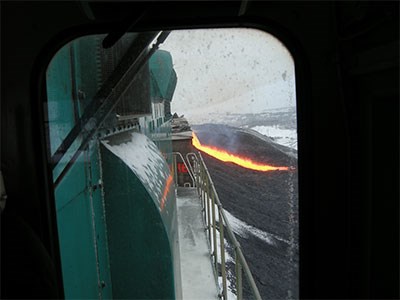Watching the sudden discharge of red-hot molten metal at the Vale slag pile has been a rite of passage for generations of Sudburians. For the Vale employees responsible for the fire and light show, it’s just a job – and not necessarily an easy or pleasant one, at least until now.
A new slag dumping system designed for Vale by Sudbury automation specialist Ionic Engineering allows operators to tip the huge steel pots by pushing buttons and operating a joystick in the comfort of the locomotive. The power comes from the locomotive itself and built-in intelligence ensures that the operation is executed safely.
The waste material from the smelting process is dumped from a furnace in the smelter into huge steel slag pots mounted on rail cars, explained Vale transportation department manager Andrew Dubowsky. Each pot holds 17 tonnes of material at a temperature of approximately 1350 degrees Celsius. There are two pots per car and, typically, six cars per train. A locomotive hauls the cars approximately 1.5 kilometres from the smelter to the slag dump.
Pouring slag hasn’t always been so easy.
Dumping the pots the old way, an operator stands outside beside a rail car – no picnic in Sudbury’s harsh winters –and attaches a Shepherd’s hook to an elevated power line. The operator plugs the cable into the car and operates a lever to tip the pot, repeating the process for each of the 12 pots on a train. As the hot, molten metal is discharged, clouds of noxious gases spew forth.
“We’ve gotten to the point where we’ve proceduralized the operation around wind conditions so the SO2 doesn’t get blown back at the operator,” said maintenance supervisor Bob Bonhomme. “We also have different slag dumps facing different wind directions, and keep the dumps cut to a point so the slag rolls down with ease and hits the ground at a safe distance.”
Once all the rail cars in Vale’s slag dumping fleet are converted, operators will never have to step outside the locomotive. They’ll be able to see all the pots on a screen, select a pot to be poured, and control the speed of the pour.
There were several design challenges that had to be overcome.
One of them was a requirement for new motors to accommodate the mechanical stress of slamming the pots following the pours to dislodge the residual buildup of hardened material called skull. Another was the design and placement of the power and communication cabling connecting the locomotive to the rail cars to protect them from exposure to the molten material.
The first phase of automating the slag dumping operation was completed in November with the conversion of six of Vale’s 21 slag cars.
Phase two of the conversion is scheduled for this year.




